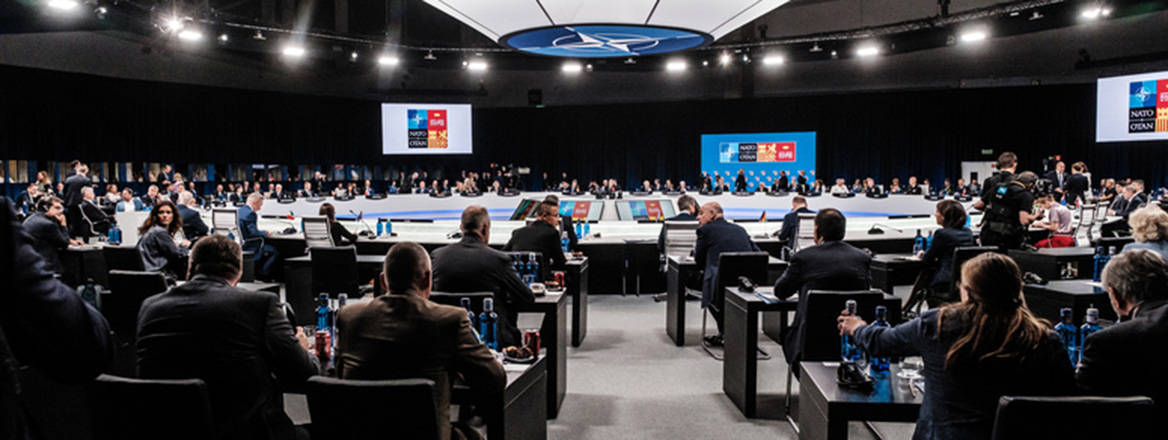RUSI
|
|
New Concepts but Old Problems: NATO’s New Strategic Concept
The plans for NATO outlined at the Madrid summit include some major changes to the Alliance’s posture. But the real work starts now in translating political rhetoric into action.

NATO has unveiled its new Strategic Concept, which defines the Alliance’s purpose to 2030. It’s the eighth in its history and comes at a decisive time for the Alliance, as large-scale land warfare returns to the European continent. Even excluding the war in Ukraine, this week’s Madrid summit would have been significant.
NATO has struggled to articulate its purpose since the end of the Cold War and especially since the 9/11 attacks, after which terrorism dominated the international security agenda. Since the previous strategic concept the Alliance has had to weather rising political tensions – on both sides of the Atlantic – during the Donald Trump presidency, including French President Emmanuel Macron accusing the organisation of becoming ‘braindead’. Operationally, NATO experienced strategic failure in Afghanistan – its most ambitious mission – brutally underlined by the 2021 fall of Kabul and the chaotic withdrawal of Western forces. The 2011 intervention in Libya produced no better outcomes. Fighting these expeditionary operations has bent the Alliance out of shape and made it more difficult to reconfigure towards conventional warfighting in Europe.
Combined with the war in Ukraine and renewed Russian aggression, the Madrid summit was an opportunity for NATO to draw a line under a 20-year period of ‘out of area’ crisis management operations, and a chance to go back to basics and focus on its core purpose: the collective defence of the Euro-Atlantic area.
Reprioritisation not Revolution
The new strategic concept is the first since the Lisbon summit 12 years ago and reflects the changes in the strategic environment in several ways. First, Lisbon assessed that ‘the Euro-Atlantic area is at peace and the threat of a conventional attack against NATO territory is low’, whereas now the ‘the Euro-Atlantic area is not at peace… We cannot discount the possibility of an attack against Allies’ sovereignty and territorial integrity’. Second, Lisbon described a desire ‘to see a true strategic partnership between NATO and Russia’, a country now identified as ‘the most significant and direct threat to Allies’ security and to peace and stability in the Euro-Atlantic area’. Third, China did not receive a single mention in 2010; now, it is described as a ‘systemic challenge’ to Euro-Atlantic security. Furthermore, the relationship between Russia and China is described as a ‘deepening strategic partnership’ which is also likely to threaten the Alliance. And then, the latest strategy document declares that ‘hybrid operations against Allies could reach the level of armed attack and could lead the North Atlantic Council to invoke Article 5 of the North Atlantic Treaty’ – a mention which, although hazy, features for the first time in an official document.
The wording has changed, but the core tasks remain broadly the same: defence and deterrence (previously collective defence), crisis prevention and management (previously just crisis management), and cooperative security. The document reprioritises away from crisis management and towards defence and deterrence. Surprisingly, given the importance of environmental issues, ‘resilience’ does not become a core task, but the cross-cutting importance of technological innovation, climate change, human security and the ‘Women, Peace and Security agenda’ all support the core tasks.
The Defence and Deterrence of the Euro-Atlantic Area
While it dominated the discussion, the Madrid summit was not just about the Strategic Concept.
While a lot of effort has gone into building consensus for Madrid, in many ways the hard work starts now
Operationally, NATO has announced a significant hardening of its defence and deterrence posture to be able to ‘defend every inch of Allied territory’ and recommitted to a 360-degree approach to security through several enhancements. First, there is a doubling from four to eight multinational battlegroups in Eastern Europe, which has already led to a near-tenfold increase in troops deployed to the Eastern flank. Moreover, these battlegroups will soon include brigade headquarters to rapidly scale up posture if necessary, with associated NATO reinforcement plans at ‘short and no notice’. Second, the NATO Response Force (NRF) has been expanded from 40,000 to over 300,000 troops, to be held at higher levels of readiness. Third, in a complete antithesis to President Vladimir Putin’s intent, Sweden and Finland will now be able to join the Alliance, after Turkey withdrew its objections in time for Madrid, significantly enhancing political unity.
The eventual accession of Finland and Sweden will expand the Supreme Allied Commander Europe’s (SACEUR) land area of operations by over 866,000 square kilometres. It also changes the European security architecture in more subtle ways. For example, it means that seven out of eight Arctic Council members will also be NATO members, changing the dynamic at a time when NATO needs to cooperate with Russia on climate security, which is also heavily stressed in the new Strategic Concept. Moreover, NATO and the EU are now more closely aligned in terms of their membership – only Austria, Cyprus, Ireland and Malta are members of the EU but not NATO – at exactly the moment when European states need to step up defensively.
These announcements are politically momentous, but also entail a huge risk. The big troop increases will be very expensive as member states experience increasing spending pressures. If these statements are not backed up (there are a total of 71 ‘we will’ commitments across 11 pages), the Alliance could lose trust and credibility, and therefore effective deterrence. There is also the real possibility of opening old wounds on burden sharing, especially between the US and European allies, which could further destabilise the Alliance, especially if a Trump-like character is able to secure election to the White House in 2024. European security documents and communiques, both from NATO and the EU, are graveyards of unrealised rapid reaction force ambitions which were luckily never tested by the security environment. It is politically unacceptable to Eastern members to continue to tolerate this risk. There are already reports that cast real doubt on the ability to realise the new force model.
How Much Does the Strategic Concept Actually Matter?
Politically, the Strategic Concept and the unity it represents are very important. However, militarily and operationally, it is less significant. The 2010 Strategic Concept had been moribund since at least 2014, following Russia’s annexation of Crimea, but of course NATO has still been operating effectively since. While a lot of effort has gone into building consensus for Madrid, in many ways the hard work starts now.
There is a coherence issue. The Strategic Concept, as NATO’s strategy, comes after the two main plans – SACEUR’s Concept for the Deterrence and Defence of the Euro-Atlantic Area and the future NATO Warfighting Capstone Concept – have already matured. There was tacit acknowledgement at the Madrid summit that many underlying operational plans would have to be revised. However, with NATO’s strategy transforming, mere tweaks to plans do not seem sufficient, and their core assumptions should be revisited. For NATO’s Warfighting Capstone Concept – how it fights in the future – it is imperative that analysis of Russia’s military performance in Ukraine now becomes the backbone for its development.
Moreover, despite the collective might of NATO, it cannot do everything, and the commitment at the 2015 Warsaw summit to a ‘360-degree approach’ to security – both thematically and geographically – risks overstretch. In a hardening world, the Alliance must take the opportunity to go back to its roots and seek support from other actors, such as the EU. It is still expected that a NATO–EU joint declaration will materialise before the end of the year.
NATO’s Russia Problem
The new Strategic Concept identifies and defines the Russian threat for the remainder of the decade. But threat identification is only half of the job, and ‘threat mitigation’ – or the actual activity – is the priority. In this regard, the document lacks the vision and a realistic timeframe for understanding the parameters of the NATO–Russia confrontation.
With economies hit by the coronavirus pandemic, the cost of living, and inflationary pressure, the ability to sustain political will on NATO funding will diminish
This is not just a NATO issue, but its self-declared ‘unique, essential and indispensable’ role in European security is important in influencing and managing Russian behaviour. The Strategic Concept states that ‘Strategic stability, delivered through effective deterrence and defence, arms control and disarmament, and meaningful and reciprocal political dialogue remains essential to our security’. To achieve this, it is first critical to understand which key tenets of European security, or parts thereof, are still in play; what can be built on; and what must be discarded. This applies to the Washington Treaty 1949; the Helsinki Final Act 1975; the Charter of Paris for a New Europe 1990; the NATO-Russia Founding Act 1997; the OSCE Istanbul Document 1999; and the Vienna Document 2011. Moreover, the Treaty on Conventional Armed Forces in Europe 1990, the Intermediate-Range Nuclear Forces Treaty 1987, the Treaty on Open Skies 1992, and the Chemical Weapons Convention 1993 all appear moribund, albeit for different reasons.
It is important that future engagement with Russia is designed in a way that incentivises cooperation and builds a structure for dialogue that reflects the future strategic environment, rather than the context of the Cold War. The fundamental problem is a lack of trust on both sides, and therefore a low likelihood of compliance if an agreement could be achieved. Collective security is not necessarily dead, but it might have to take a back seat for a while as we return to balance-of-power politics for the foreseeable future. NATO members need to be prepared for the consequences.
In for the Long Haul
Despite Ukraine not being a member of the Alliance, the outcome of the war is critical to NATO, European security, and the principle that aggressors cannot redraw international borders by force. NATO has now stated that ‘A strong, independent Ukraine is vital for the stability of the Euro-Atlantic area’, and it must follow through with action. However, the announced enhancements to NATO’s defence and deterrence posture will come at an eyewatering cost to NATO common funding, which will fall on national defence ministry budgets that are already under strain when it comes to delivering extant equipment budgets. Moreover, with economies hit by the coronavirus pandemic, the cost of living, and inflationary pressure, the ability to sustain political will on NATO funding will diminish.
Critical to this will be the ability of governments to communicate the Russian threat to their populations clearly and transparently. They need to effectively bring to life national security risk assessments to make the case for sustained higher spending, and ‘Putin equals bad’ messaging is insufficient. This struggle goes beyond Putin, and we need to ensure we don’t make the mistake of assuming that what comes next is automatically better.
Russia’s 2014 annexation of Crimea was a wakeup call that the Alliance didn’t fully grasp. Some modest transformation did occur, such as the creation of the NRF and Enhanced Forward Presence, as well as the recommitment to spending 2% of GDP on defence by 2024 at the 2014 Wales summit. However, the political rhetoric was not backed by commitment, which weakened NATO deterrence and might have inadvertently influenced Putin’s decision-making calculus towards Ukraine. If NATO fails to translate words into action now, it could be fatal for the Alliance.
The views expressed in this Commentary are the author’s, and do not represent those of RUSI or any other institution.
Have an idea for a Commentary you’d like to write for us? Send a short pitch to commentaries@rusi.org and we’ll get back to you if it fits into our research interests. Full guidelines for contributors can be found here.
Original article link: https://rusi.org/explore-our-research/publications/commentary/new-concepts-old-problems-natos-new-strategic-concept


